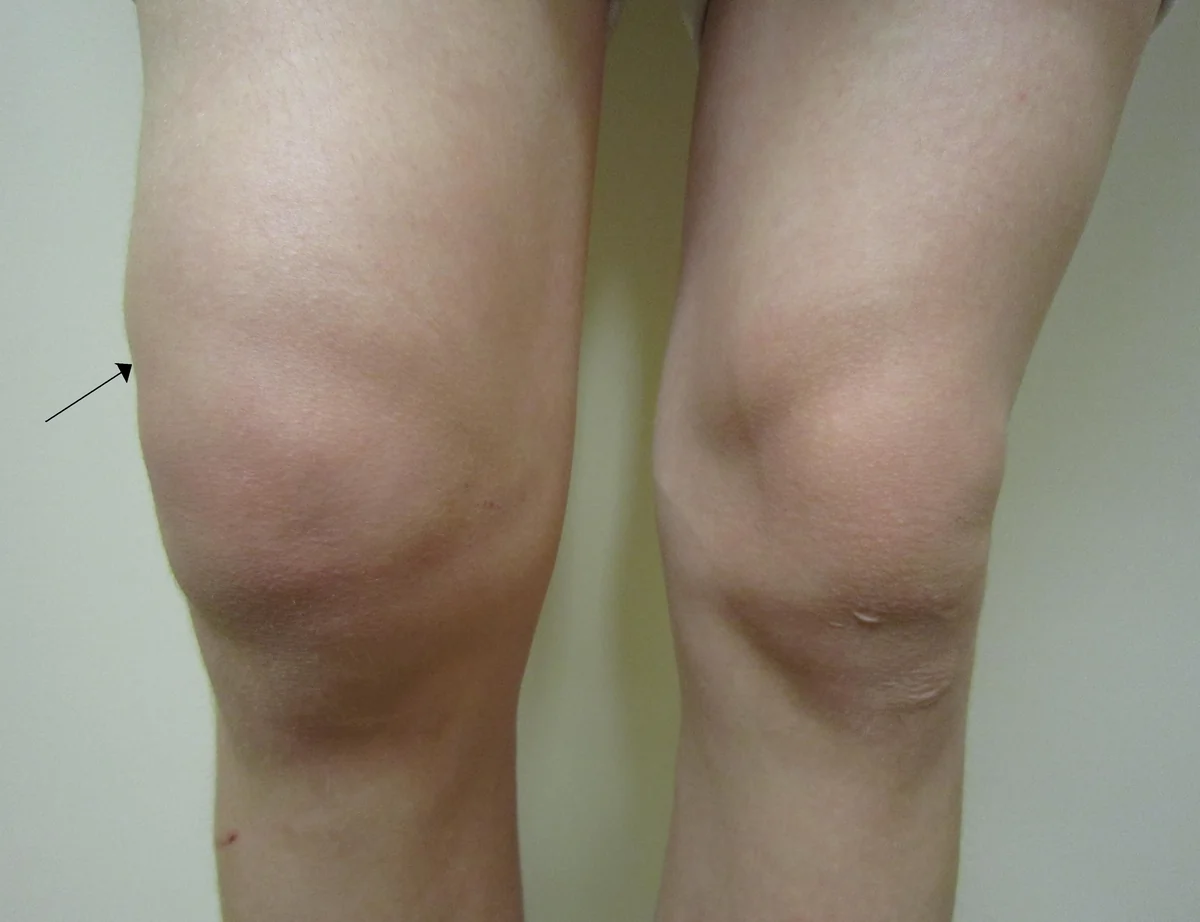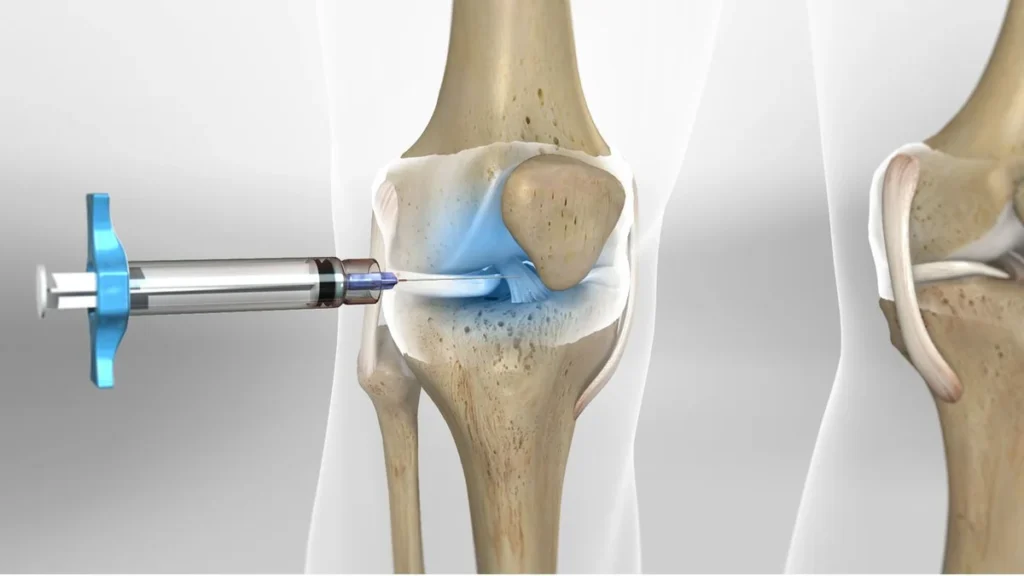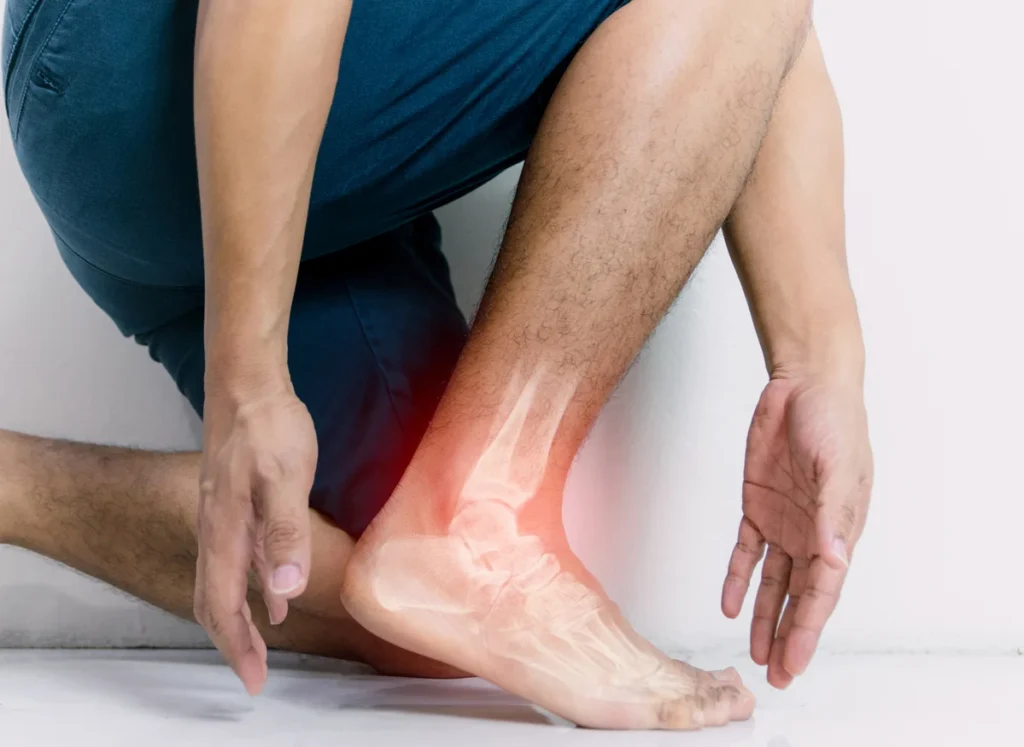Knee effusion is a condition where excess fluid accumulates around the knee joint. This problem often results from factors such as infection, arthritis, and knee injuries. When the knee experiences effusion, blood, fluids, and other particles can gather around the knee, causing swelling.
A swollen knee may not be painful in its normal state, but when swelling is due to knee effusion, there is a likelihood of pain in the affected knee and difficulty in fully bending and straightening it, as well as pain when walking.

Symptoms of Knee Effusion
- Swelling: In cases of knee swelling, the skin around the knee joint will noticeably enlarge compared to a normal knee.
- Restricted movement: The patient may not be able to fully bend or straighten the knee as the excess fluids in the joint prevent these movements.
- Pain: When the knee is bent, the increased volume of fluids exerts significant pressure on the knee joint, causing unbearable pain. In English, knee effusion is known as “effusion.” It’s worth mentioning that a small amount of fluid is normally present in the knee joint and does not cause any problems. However, after injury and inflammation, the knee becomes swollen and painful.
Causes of Knee Effusion
Knee effusion can be due to various factors:
- Arthritis: One of the most common types of knee arthritis results from the wearing or tearing of the protective cartilage at the end of the bone. This disease can occur in any joint of the body but mostly affects the hand, hip, knee, and spine joints. Over time, this leads to inflammation, swelling, and eventually knee effusion.
- Rheumatoid arthritis or rheumatoid arthritis: This joint disease is a chronic joint inflammation accompanied by pain, swelling, redness, and stiffness. It can also cause inflammation in muscles, ligaments, and tendons. Rheumatoid arthritis is an autoimmune disease of unknown origin, characterized primarily by inflammatory arthritis that may lead to knee effusion.
- Gout: This disease results from the accumulation of uric acid in the body, causing joint pain and eventually knee effusion.
- Pseudogout: Similar to gout, but caused by the accumulation of another substance called calcium pyrophosphate around the joints.
- Trauma or injury: Severe blows or acute injuries to the knee, especially during sports activities, can cause swelling, pain, and stiffness in the knee. These types of injuries include meniscus tears, ligament tears, bone fractures, etc.
- Tumors: Tumors and cysts that form in the knee can irritate the surrounding tissue, leading to knee effusion.
- Lyme disease: This disease initially presents with symptoms such as fever, chills, fatigue, headache, swollen lymph nodes, and joint and muscle pain.
- Psoriatic arthritis: This is a type of joint inflammation that affects people with psoriasis. This disease also brings dryness, pain, and swelling, which may lead to knee effusion.
- Bursitis: Swelling of the small fluid-filled sacs that separate the knee bone from muscles and tendons.
- Infection: Infections caused by diseases like tuberculosis, gonorrhea, and brucellosis can cause inflammation and swelling.
Is Knee Effusion Dangerous?
Yes, knee effusion indicates a serious problem in the knee that should be treated immediately. Once fluid accumulates in the knee, the best course of action is to consult a knee specialist or orthopedist to quickly diagnose and treat your knee issue.
What Does Knee Effusion Indicate?
The accumulation of fluid around the knee indicates inflammation or a problem in the knee. This issue could be due to diseases like gout, arthritis, or serious knee injuries, which cause joint fluid to accumulate around the knee. Therefore, knee effusion is not a good sign and should be promptly examined and diagnosed by a specialist.
Complications of Inflammation and Knee Effusion
- Muscle volume reduction: The fluids in the knee may damage muscle function, leading to weakness and atrophy of the thigh muscles.
- Baker’s cyst (fluid-filled sac): Excessive fluid accumulation in the knee may lead to the formation of a Baker’s cyst behind the knee.
When to See a Doctor for Knee Effusion?
When home care measures and prescribed medications do not relieve swelling and pain, or if one knee becomes redder and more swollen than the other, it is necessary to consult a doctor for further examinations and clinical treatment.
How to Diagnose Knee Effusion?
Since knee effusion itself is not a disease but an indicator of other conditions such as arthritis, trauma, or infection in the knee, the doctor will use various methods like ultrasound, X-ray tests, blood tests, MRI, and joint fluid analysis to diagnose the underlying cause of the knee swelling.
Clinical Treatments for Knee Effusion
In medical science, various methods are used to treat knee effusion. These methods include draining knee joint fluid, physiotherapy, knee joint replacement surgery, and medication as common approaches for managing and treating knee effusion.
Draining Joint Fluid
Draining knee joint fluid and using medications only help reduce symptoms caused by knee effusion. For definitive treatment, diagnosing the primary cause of knee effusion is essential.
Common Treatments for Knee Effusion
To resolve the issue of knee effusion, treatment and care are needed. The treatments for knee effusion include:
- Medications: Medications related to the treatment of knee effusion include antibiotics, pain relievers, and corticosteroids.
- Antibiotics: These drugs are prescribed when knee effusion is caused by an infection.
- Pain relievers: Pain relievers are prescribed by doctors to reduce pain. If standard pain relievers do not alleviate the pain, stronger pain medications may be prescribed.
- Corticosteroids: These are strong anti-inflammatory drugs and may be prescribed in pill form or injected into the knee joint.
- Medical knee braces: Using a medical knee brace is effective in reducing strain on knee tissues and supporting the knee joint. Wearing this brace is very beneficial for patients with knee arthritis, as it prevents pressure on the injured knee.
- Knee joint replacement: In cases where knee effusion is due to severe osteoarthritis, artificial joint prostheses are used to replace the knee joint to reduce pain and swelling. Knee joint replacement should be performed by a specialist to achieve the best outcome from this treatment method.
- Knee arthroscopy: In knee arthroscopy, the doctor inserts a flexible tube with a camera into the knee to repair cartilage damage or cleanse various tissues of the knee.
- Physiotherapy: Physiotherapy is performed to strengthen and improve the range of motion of the knee. During physiotherapy, various techniques such as cryotherapy, ultrasound, and scraping are used.
Is Draining Knee Fluid Harmful?
When the knee experiences effusion, the doctor may aspirate the knee fluid with a needle for testing and diagnosing the primary cause of pain. This procedure is known as arthrocentesis. When draining knee fluid, blood, pus, and yellow fluids may be drawn into the needle.
Many people may worry that this procedure could be dangerous and increase knee pain. However, it’s necessary for diagnosing the cause of knee pain. In addition to draining knee fluid, radiography, CT scans, biopsies, MRI, and joint fluid sampling are used for diagnosing and treating knee problems.
Injections for Knee Effusion
The use of corticosteroids for treating various knee diseases, such as knee effusion, is common. Although cortisone injections can reduce knee pain, they are not a definitive treatment. Injecting cortisone into the knee disrupts knee signal pathways and reduces pain. After the knee pain diminishes, you may be able to move your knees more comfortably and feel less pain for a while. Many professional athletes use cortisone injections in their knees to enhance their sports activities.
Does Knee Fluid Get Absorbed?
If your knees have effusion, you should not leave them untreated in the hope that the fluid will be absorbed. Instead, you should consult an orthopedic specialist for treatment to prevent mobility disabilities and severe knee pain.
Home Treatments and Care for Knee Effusion
If you are dealing with knee inflammation, there are home remedies you can use to alleviate this issue. For treating knee effusion, you can benefit from these home treatments and care:
- Rest: When knee swelling is in the painful and swollen stage, avoid putting pressure and weight on the knee. Rest and reduced activity are very beneficial for the patient in this condition.
- Cold Compress: To control pain and swelling of the knee, using a cold compress and keeping the knee elevated above heart level is appropriate. Apply a cold compress to the knee two to four times a day for 15 to 20 minutes.
- Elevating the Knee: When using a cold compress, elevate the knee using a cushion to a higher point above the heart level. Also, when sleeping, you can elevate the knee by placing a pillow under it.
Traditional Treatments for Knee Effusion
Some people use traditional and herbal remedies to treat knee effusion. Oils and substances like olive oil, eucalyptus oil, consumption of marigold and linden flowers, and hot pepper oil can be used to reduce knee pain. However, for definitive results, it is best to consult a knee specialist and surgeon.
Tablets and Ointments for Treating Knee Effusion
Tablets and ointments may help reduce knee pain following swelling and inflammation. However, for definitive treatment, it is best to consult a specialist.
- Tablets like acetaminophen and naproxen are helpful in reducing knee pain. Topical ointments such as “Joint Pain Ointment” can also be used to reduce knee pain.
Exercise for Treating Knee Effusion
To prevent fluid accumulation around the knee and reduce knee inflammation, exercise, and physical movements are beneficial. Stretching exercises can increase the flexibility of hamstring muscles and muscles around the knee.
- For stretching muscles around the knee, stand straight, bend your waist, and reach your hands to the tips of your feet without bending your knees.
- The next movement, standing on tiptoes, helps strengthen the quadriceps muscles.
- The following exercise strengthens the inner thigh muscles. Lie on your side and place a pillow between your legs. By applying pressure to the pillow between your legs, you can strengthen the muscles around the knee and reduce the pressure caused by knee effusion.
Physiotherapy for Treating Knee Effusion
For treating knee swelling and pain, physiotherapy can also be beneficial. For physiotherapy exercises, it is best to consult a physiotherapy specialist and have appropriate exercises determined for you. Physiotherapy sessions help increase the flexibility of joints around the knee and reduce knee pain and swelling. Therefore, to improve the flexibility around your knees, consult a professional physiotherapist.
Who is More Likely to Experience Knee Effusion?
Excessive pressure on the knee can lead to fluid accumulation around the knee and knee swelling. People who are overweight may exert more pressure than normal on their knees, leading to knee effusion. Gardeners, farmers, and others who perform heavy tasks should avoid putting extra pressure on their knees.
Professional athletes in sports such as wrestling, football, basketball, volleyball, weightlifting, or lifting should prevent sudden movements and twisting of the knee. Also, aging and diseases like gout and arthritis play a role in knee effusion. In general, attention should be paid to the health and normal condition of the knees to prevent problems.

To make an appointment or get an online consultation with Dr. Nader Motallebi Zadeh, Limb lengthening surgeon, proceed here.
Thank you for reading this article. Please ask your questions in the comments section.



